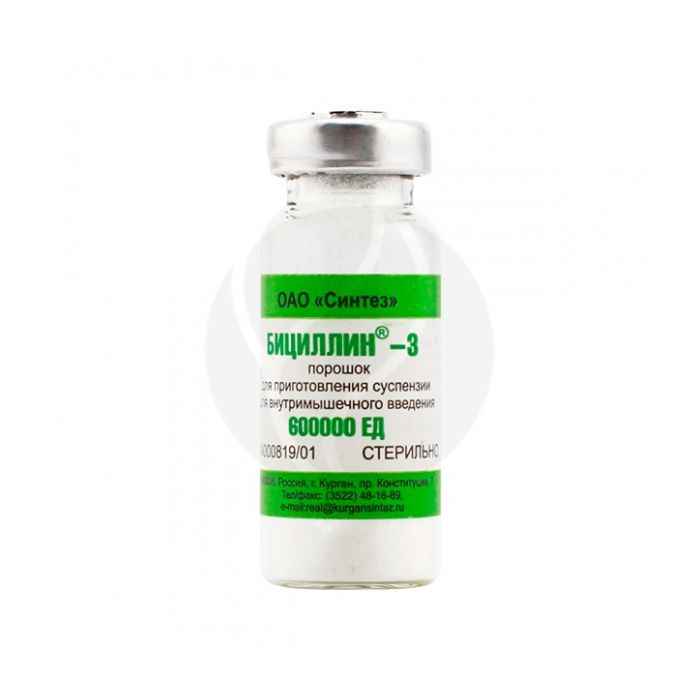Bicillin-3 powder for prig. suspension d / v / m introduction 600000ED, No. 1
Expiration Date: 05/2027
Russian Pharmacy name:
Бициллин-3 порошок д/приг. сусп. д/в/м введения 600000ЕД, №1
Treatment of infectious diseases caused by pathogens sensitive to penicillin, syphilis, yaws, streptococcal infections (acute tonsillitis, scarlet fever, wound infections, erysipelas), with the exception of infections caused by group B streptococci, prevention of rheumatism, leishmaniasis.
Bicillin-3 is injected deep into the upper outer quadrant of the buttocks at a dose of no more than 1.2 million units. If necessary, 2 injections are made into different buttocks. Repeated injections are carried out 4 days after the previous injection.
IV administration of the drug is prohibited.
Rules for the preparation and administration of the solution
Bitsillin-3 suspension is prepared immediately before use. 2-3 ml of sterile water for injection or isotonic sodium chloride solution are injected into the vial with the drug. The mixture in the vial is shaken for 30 seconds (in the direction of the longitudinal axis) until a homogeneous suspension (or suspension) is formed, which is injected deep into the upper outer quadrant of the buttock. Rubbing the buttocks after injection is not recommended.
Powder for preparing a suspension for intramuscular injection is white or white with a slightly yellowish tinge, forming a stable suspension when water is added.
1 fl.
a mixture of benzathine benzylpenicillin, benzylpenicillin sodium (or potassium) salt and benzylpenicillin novocaine salt 600 thousand units
-'- 1.2 million units
Hypersensitivity to penicillins and procaine (novocaine),
bronchial asthma,
hay fever,
other allergic diseases.
pharmachologic effect
Combined antibacterial drug of the group of prolonged-release penicillins, which are destroyed by penicillinase. The mechanism of action is based on a violation of the synthesis of peptidoglycan - a mucopeptide of the cell membrane, which leads to inhibition of the synthesis of the cell wall of the microorganism, suppression of the growth and reproduction of bacteria.
Active against gram-positive bacteria: Staphylococcus spp. (not producing penicillinase), Streptococcus spp. (including Streptococcus pneumoniae), Corynebacterium diphtheriae, Bacillus anthracis; gram-negative bacteria: Neisseria gonorrhoeae, Neisseria meningitidis, Actinomyces israelii.
The drug is also active against Treponema spp., Anaerobic spore-forming rods, Leishmania.
Staphylococcus spp., Which produce penicillinase, are resistant to the drug.
Pharmacokinetics
Suction
With a single administration, it remains at an average therapeutic concentration for 6-7 days. Cmax in blood plasma is reached 12-24 hours after administration.
After the introduction of Bitsillin-3 at a dose of 2.4 million units, the concentration in the blood serum on the 14th day is 0.12 ?g / ml; after the introduction of Bicillin-3 at a dose of 1.2 million units, the concentration in the blood serum on day 21 is 0.06 ?g / ml.
Distribution and metabolism
After i / m administration, it slowly hydrolyzes with the release of benzylpenicillin.
It undergoes biotransformation to an insignificant extent.
Plasma protein binding - 40-60%. Passes through the placental barrier, enters breast milk.
It is well distributed in liquids, while the distribution in tissues is low.
Withdrawal
It is excreted mainly by the kidneys.
Side effect
Allergic reactions: urticaria, angioedema, erythema multiforme, anaphylactic shock, arthralgia, fever, exfoliative edema.
From the digestive system: stomatitis, glossitis.
From the side of the blood coagulation system: anemia, thrombocytopenia, leukopenia, hypocoagulation.
Others: with prolonged use - superinfection, mycoses.
Application during pregnancy and lactation
Data on the use of the drug Bitsillin-3 during pregnancy and lactation (breastfeeding) are not provided.
special instructions
If allergic reactions develop, treatment should be stopped immediately.
With the development of anaphylactic shock, anti-shock therapy is indicated (administration of norepinephrine, GCS, mechanical ventilation).
Intravenous and endolumbar administration is not allowed, because the development of Wanier's syndrome (depression, anxiety, paresthesia, visual impairment) is possible.
In the treatment of sexually transmitted diseases, if syphilis is suspected, microscopic and serological examinations are necessary before starting therapy and then within 4 months.
In connection with the possible development of fungal infections, it is advisable to prescribe antifungal drugs (nystatin, levorin), as well as ascorbic acid and B vitamins.
It should be borne in mind that the use of the drug in insufficient doses or early termination of treatment leads to the emergence of resistant strains of pathogens.
Overdose
Currently, no cases of overdose of Bitsillin-3 have been reported.
Drug interactions
With simultaneous use with bactericidal antibiotics (including cephalosporins, cycloserine, vancomycin, rifampicin, aminoglycosides), synergism of action is noted; with bacteriostatic antibiotics (including macrolides, chloramphenicol, lincosamides, tetracyclines) - antagonism.
Bicillin-3 reduces the effectiveness of oral contraceptives and ethinyl estradiol (risk of breakthrough bleeding).
With the simultaneous use of Bitsillin-3 with allopurinol, the risk of developing allergic reactions increases.
Pharmacokinetic interaction
With the simultaneous use of diuretics, allopurinol, phenylbutazone, NSAIDs, reduce tubular secretion and increase the concentration of penicillin.

